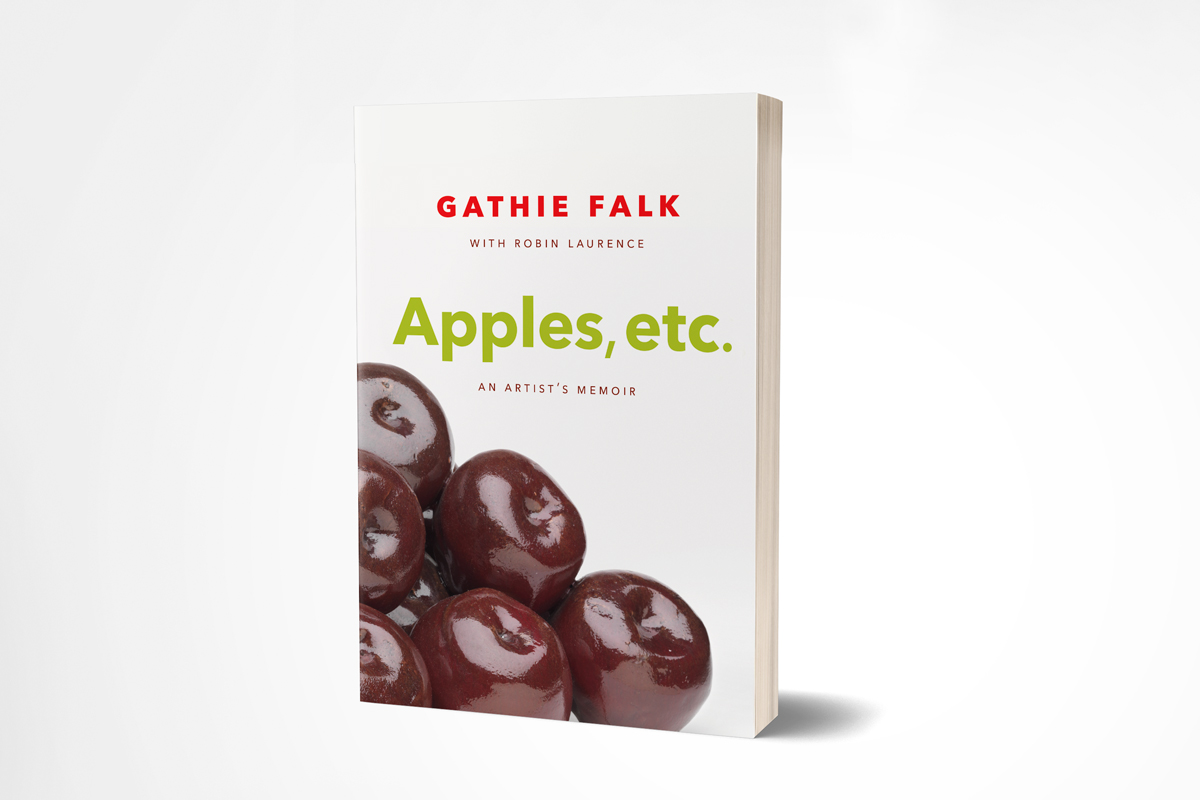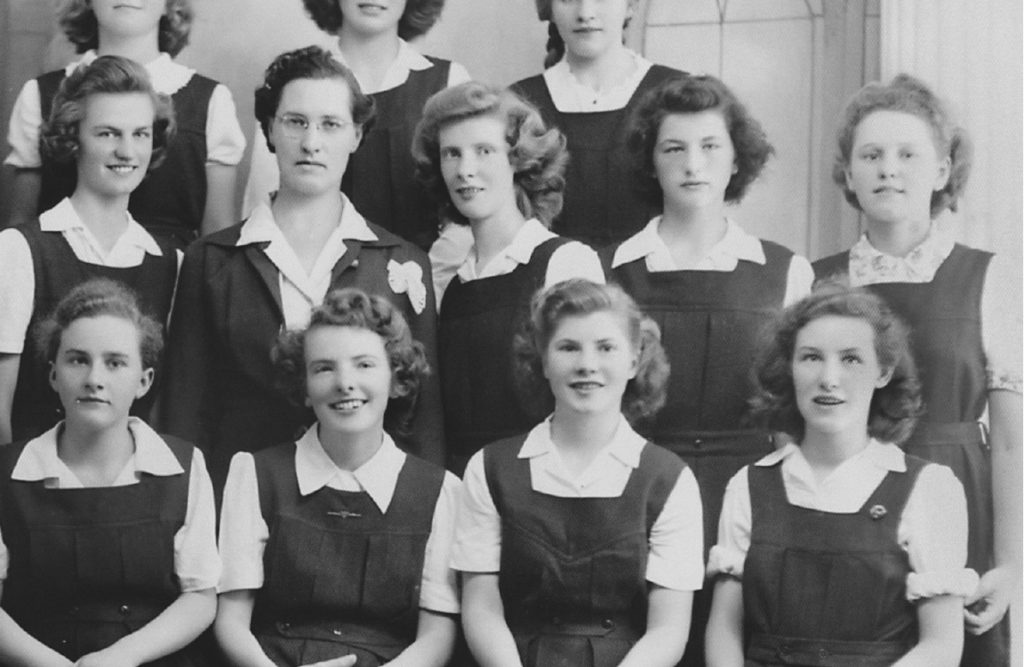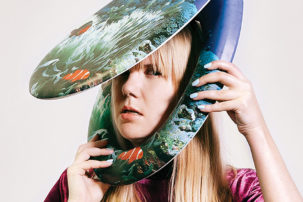There was a time, long ago, when I thought I would like nothing more than to be a street-corner musician. What I became, and have been for many years, is an artist. Not a singer, not a pianist, not a violinist, but a visual artist.
My apprenticeship was a long one. I was born, in the little sheep town of Alexander, Manitoba, on January 31, 1928, two years after my Mennonite parents fled to Canada from Russia. My father died when I was ten months old and my brothers were nine and three. After that, our lives were marked by poverty and frequent moves from place to place, and we often depended upon the charity of others. But I was a maker from the earliest days.
I remember sitting on a windowsill when I was about two, holding a pair of scissors, saying “scissors” out loud and triumphantly. I learned how to put them to good use. I cut a hole in a piece of cloth and tied a string around the waist to make a doll dress. Family and friends said, “Oh, she’s going to be a seamstress,” which disturbed me. That was never my ambition. Still, when I was in my teens, I designed my own dresses, which my mother sewed for me, and later, I made my dresses myself. Later still, I earned my living sewing, not dresses but pockets for suitcases.
From a very young age, I wanted to know how to draw, and I thought my elders could show me the way. When I was about three, I insisted that my mother should draw me a picture. This was during a period when I was being treated for eczema. There were no doctors in our rural Mennonite community; my mother, like others there, relied on home remedies. The one used on my eczema was a mixture of cow dung, mud, and tar, applied every evening after dinner. It stank and it burned and I’m sure I complained bitterly, but on it went. I remember that I sat on my mother’s well-protected lap during the treatment—and we were not a lap-sitting family—until it dried. After I had endured this foul mixture and been washed clean, I could sit in her lap again while she told me a story, the same story about a baby duck, lost and then found again, over and over, much to my brothers’ disgust.
One evening I asked her to draw me a picture of a woman, a mama. She said no. I kept saying, “Draw me a picture,” and she kept saying no, until she eventually relented. She somehow procured a pencil and a sheet of paper and, holding the pencil in her fist, she drew a series of strong vertical lines. I can still see those pencil marks, up and down, up and down, no bulges, no curves.
“There,” she said.
I objected. “No!”
“What?” she asked.
“A head!” She put a tiny head at the top. “And feet,” I said. She did that and said, “There! Finished!”
I demanded arms. She drew long loose arms waving on each side of the body and again said, “Finished!”
I protested, “Chickens!”
She drew chickens, and then declared, “That’s the last drawing I will ever make for you!”
I asked why and she said, “Because I can’t draw.” And that was true.
In those early days, there were no materials for making art in our home, no crayons or coloured pencils or paint. The only paper we had was kept on a high shelf and used for letters. During the brief period of my mother’s second marriage, I was given a set of watercolours for Christmas. I didn’t know what to do with them. I wanted perfection, but I couldn’t control the sloppy wet marks I made.
I don’t remember exactly when my drawing tools and I came together in a satisfactory way. It might have been when I was at school in Winnipeg, in grade two. I was obsessed with drawing heads, but they were a source of worry to me. They didn’t look right. For a time I did as the other children in my class did, tracing a circle around the top of a paste bottle, then adding a couple of dots and a semicircle—eyes and mouth. It seemed like a simple solution to my drawing problem, but I was not really happy with those unnaturally round and simple heads either.
At home one day, I asked my brother Jack to draw a head. He was, after all, much older than I was. Surely he knew how. He took on the assignment and worked seriously, drawing and erasing and drawing again and erasing again to get it right. He handed his effort over with some satisfaction but, to my horror, it looked awful. I said so. “Well then,” he told me with some annoyance, “draw your own heads.”
Eventually, I did. By grade four or five, I was repeatedly drawing two fantasy pictures. The first was of a glamorous woman in a long dress with an upswept hairdo and a fur stole. The other was of a girl’s playroom loaded with dolls, dozens of dolls, and all the other toys I wished I had—a doll carriage, a dollhouse, doll clothes.
One day, my teacher, the dreaded Miss Vanderhoek who had once strapped me for being late, took my drawings away from me. With a sarcastic “Look what she’s been doing!” she put them up on the chalkboard for all to see. I think her intention was to embarrass me because I had been drawing in class instead of reading my geography book, but it was also a mark of distinction. I felt humiliation and pride—definitely a mixed experience. I knew she admired my drawings because a few years after that, when I was thirteen, she recommended me to take part in Saturday-morning art classes in downtown Winnipeg. This was a privilege granted to just a few of the most talented kids in each school.
The art lessons were also a mixed experience. I didn’t always have the money for transit fare there and back, five cents each way. The classes, which were big, were in a civic building on Vaughan Street that had a museum in the basement, an auditorium on the main floor, and an art gallery on the top floor. My brother Gordon and I had sometimes slipped into the museum and art gallery on our unsupervised expeditions downtown, but my memory is that the gallery was always unlit when we were there. If we stayed long enough, images might coalesce out of the darkness.
The first art lessons I attended were in the basement museum, sitting on the floor, drawing the stuffed animals in their glass cases. This was my first experience of drawing from life—if you could call taxidermic animals “life.” Previously I had created images out of my imagination or copied photographs in magazines. My work was typical of a child’s first efforts at depicting the unfamiliar: a tiny creature stranded in the middle of a large piece of paper. The instructors said, “Bigger, bigger, bigger!” It was a very fearful exercise.
Later we were promoted to a less frightening area of the building, but I was depressed because all the other children drew and painted better than I did. They took instructions better too. I was told to use colours that made no sense to me. I was stubborn in my convictions about how things looked and should be represented. After a year or so, we had a few art history classes, during which the instructors showed us reproductions of Impressionist and Post-Impressionist paintings. When they brought out a picture of a vivid reddish-orange dog painted by Paul Gauguin, I decided that I had had enough of this school. Like most young teenagers at the time, I was a realist. Dogs weren’t orange! I took my pastels and went home. I didn’t go back.
Music filled the creative void for a time—singing in the church choir, for one. Also taking voice and conducting lessons through the help of an anonymous donor whose name I never learned. But then my promising existence came to a crashing halt.
In my mid-teens, after completing grade nine, I had to drop out of school. My family still owed money to Canadian Pacific Ships for the steamship passage that had brought them as immigrants to Canada from Russia. The company had suspended its demands for repayment during the Depression, but afterwards, when most people were doing better, it tracked us down and pounced. By that time, my brothers had both left home; Jack was married and Gordon was engaged. My mother was sickly and had never learned English. The burden of repayment fell to me. While going to school, I had worked part-time picking strawberries, cleaning house, babysitting. But now I had to find a full-time job.
For the first summer, I looked after a three-year-old girl. The child was naughty, the work was mind-numbing, and there was little money in it. Then I found a job in a Macdonalds Consolidated warehouse, filling cellophane bags with raisins, dates, brown sugar, peas, beans, and chocolate rosebuds to be sold in Safeway stores. A lot of women shared this work, and they also shared stories about themselves and what they’d done on the weekend. When the others discovered I was taking voice lessons, they asked me to sing for them. I did, and they quickly closed all the windows because my voice was so loud. Together we sang all the popular songs of the day, including the war songs that promised love and laughter and peace ever after. The singing helped alleviate the boredom of standing in front of big metal tubs mounted on long trestle tables, filling bags, weighing them, then folding, stapling, and packing them into wooden crates.
My teachers deplored the fact that I was dropping out of school—and I did too. I minded the menial work much less than having my education cut short. I was a very good student, I loved learning, and, naturally, I wanted a bright future for myself. Leaving school caused me immense distress. However, during the second year of my warehouse work, I discovered that I could finish high school by correspondence. This meant that I had to stop my music lessons but not singing in the choir. By then I had made my way through the music theory book and was also able to conduct small singing groups. Still, it was a tough grind, working full-time, studying at night and on weekends, and attending choir rehearsals.
By June 1946, I had repaid the CP debt and written all my grade ten exams, passing with the highest marks in the province. This was the end of my life in Winnipeg. At eighteen, I moved with my mother, brother Gordon, and sister-in-law Edith to the golden land of British Columbia. Jack and his wife, Vera, were living in Vancouver, and my mother had cousins who lived in the Fraser Valley and spoke glowingly of it. Mother always had a dream of living again in the country, on a little farm with a cow and chickens, making bricks, drying them in the sun, building our own house. For a while this dream appealed to me too. But it didn’t happen—picking raspberries, plucking chickens, waitressing in a Chilliwack hotel, none of it worked well for us, and we were too far from church and family.
In the spring of 1947, my mother and I moved again, zooming like homing pigeons to Vancouver. I realized that I loved cities: I loved having access to a big library and to all the other amenities of urban life. We rented two rooms in a house on 25th Avenue, near Fraser Street, and found a church we could easily walk or bus to. With the church and its choir, we had the gifts of friends and a community. I went job-hunting at once, and there’s a dull grey photo of me, taken by a street photographer downtown. I am wearing a raincoat and babushka, and my expression is grim. Very grim. I was heading out from the government employment agency to my first job in Vancouver, in a luggage factory.
My task there was to sew pockets for the inside of suitcases. The pockets were elasticized at the top, the fabric was cut at an angle, across the grain, and it was very hard to feed the elastic and the cloth into the sewing machine at the same time. Although I had sewn many of my own clothes at home in Winnipeg, I wasn’t used to operating a power sewing machine. It seemed as if I broke hundreds of needles. The foreman, Jim, was very kind, very tolerant. He stood near me, one arm wrapped around his waist, leaning on the elbow of the other arm, with his face in his hand. As soon as the needle broke, he put in a new one. Eventually I mastered the machine and earned the nickname Speed.
I was very grateful to Jim for his long-suffering care. We became good friends, and when he suggested I move to another luggage factory where he would be the new foreman, I followed him there. It was a good job for a while, but we had come from a unionized shop to a place that wasn’t—and that didn’t raise anyone’s wages. To my dismay, the men were paid more than the women. When I took up this issue with the boss, a fine person, he said men should be paid more because they had families to support. I said that I had to support my mother. His response was to offer my mother a job as a domestic worker in his household. I cried. I could not explain that my mother was fragile, mentally and physically. That she couldn’t speak English. That she would never be able to work for a stranger. I just cried.
The luggage factory work took dexterity but, again, it was terribly boring. Still, my life was crammed full. I had resumed high school correspondence courses, and each day I would ride my bicycle to work, study during my lunch periods, read a book as a treat during my coffee breaks, go home, have my dinner, study some more, and go to bed. Somewhere in there, I also took music lessons, sang in two choirs, and practised my violin.
The violin was a gift from my mother, and it was my first Christmas present in Vancouver. It was an old instrument found by my brother Jack in a second-hand shop on Main Street, but it served its purpose. In January 1948, I began violin lessons with Walter Neufeld and music theory lessons with his brother, Menno. After studying for six months, I played the grade one violin exam and got first-class marks. I jumped to grade five violin the next year and did not get first-class marks. In my third year of lessons, I barely passed the grade six exams.
It became clear that I had hit a wall. I was not going to be an accomplished violinist, not even a street-corner musician. I developed severe, debilitating pain in my arm and shoulder, and I could hardly lift a cup, never mind do my work or play the violin. It might have been neuritis or some form of repetitive strain injury, but it seems to me now that there was a strong psychological component to this pain. I was sick and tired of working in a luggage factory. I couldn’t continue with the violin. I was completely flattened.
My mother and Walter could see how depressed and discouraged I was and decided I should become a schoolteacher. I was furious at them both for making this decision for me. I never, ever wanted to be a teacher. I had a vision of myself walking up and down the aisle by the windows, dictating spelling words to the kids. That image was unspeakably dreary.
Earlier, during a music lesson, Walter had asked me, “What would you really like to do?” The next week, after much thought, I said, “I would like to be an artist.” Not much came of Walter’s question and my answer, at least not then. But there it was. I wanted to be an artist.
This post is excerpted from Apples, etc.: An Artist’s Memoir by Gathie Falk with Robin Laurence. The book is out this month from Figure 1 Publishing.
 Apples, etc. was written by Gathie Falk with Robin Laurence. Photo: Figure 1 Publishing.
Apples, etc. was written by Gathie Falk with Robin Laurence. Photo: Figure 1 Publishing.

 Gathie Falk, seated at lower right, with her Mennonite girls’ group in 1944. Photo: Courtesy the artist and Figure 1.
Gathie Falk, seated at lower right, with her Mennonite girls’ group in 1944. Photo: Courtesy the artist and Figure 1.







